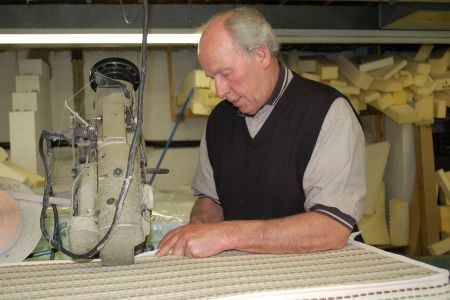As a manufacturer, Herb Verhoeven hasn't kept up with the times but he never loses sleep over keeping it old school.
The affable owner of North Star Bedding in Sudbury still produces the same mattresses and box springs as he did when he started 22 years ago. He doesn't mass produce, doesn't cut corners, and still chooses the highest quality components for his products. For him, taking the extra steps to produce a quality product has always been his mission.
“Everything has been cut back. The big companies don't do what I do, but people don't know any better,” he said. “Joe Public has been conditioned by the marketing of the big mattress makers in Canada, but no one knows what is inside your mattress or how it is made.”
His Walnut Street facility is the only mattress factory north of Toronto. He has supplied hospitals, colleges, universities and seniors' homes all across the North, along with hotels, motels, and the more than 1,200 lodges and resorts he values as his long-term customers.
Walk-in customers are welcome, but don't expect to just buy any mattress. Verhoeven wants to custom make one that will last for years.
“The most important thing for me is when you come in looking for a mattress, I need to find out what you have been sleeping on before. I need to know what firmness you like, what problems you have been having and then make your bed accordingly,” he said. “Some beds I wouldn't even sell to you because I know they wouldn't be right for you.”
The tailor-made mattress would also be sold at a wholesale price since Verhoeven sells direct from his facility.
He bristles at new products, such as the no-flip mattress, that sacrifice quality at the expense of an unsuspecting consumer. They have pillow tops on only the top and claim to be turn-free.
“I refuse to make no-flip mattresses,” he said. “It's just half a mattress which is cheaper to make. I have one here in the showroom but it's only to show customers why they shouldn't buy one. I could sell 100 time more mattresses if I did make the no-flips, but they would only last six months to maybe three years.”
Mattresses need the same layers on both sides so they can be flipped regularly to avoid getting the indents and contours that come from sleeping habits.
Verhoeven was in the furniture business before deciding to start making mattresses. He spent a year researching the business and trying to find the best equipment. He had a lot of contacts in the industry and most told him he wouldn't survive.
“I knew I could do it,” he said. “I have been here for 22 years but the first 10 years wasn't easy. I survive by doing my homework and by always paying my suppliers. Without them, you have nothing.”
From his suppliers, Verhoeven gets 20 different types of coils, textiles, and more than 40 different types of density of foam.
He only purchases coils from Canada since he said many off-shore countries make them with recycled steel.
“I can make an inexpensive mattress look like a Cadillac,” Verhoeven said, “but I know what is cheaper foam and I know the gauge of the steel in the coils. I make a quality product by using quality products.”
His construction process has been the same over the years. The layers of material that go over the box springs and mattresses are attached to each coil with a hog ring, a special stapler, to avoid shifting.
“Beds have been made like this for 100 years and it is the old way of doing it. It means more labour but I don't get beds back because of poor construction,” he said.
The edges of the box springs and mattresses are also packed with scraps of foam to protect them. The extra step is a rarity and won't be found in mass produced beds, Verhoeven said.
The tape edge closing machine, which is the finishing touch of the beds, is only operated by Verhoeven. It's the same one he purchased when he first started and said there are very few who know how to use them.
“It's hard to train someone on these so I do it myself,” he said. “And by doing this, I can also see everything we make so it is sort of like quality control.”
Customers often come in with requests for custom-made mattresses for odd-sized antique beds, three quarter beds, or even for cribs. He has also made cushions for items such as deacon benches and he can replace the foam in worn-out couch cushions.
“I really don't mind doing that,” he said. “It makes them happy and who knows, they might buy their next mattress from me.”
He makes mattresses for adjustable beds, and also sells the frame, at a competitive cost.
“There is no way you should be spending more than $3,000 on a bed. Nothing is worth that, that you can put in it, unless you have gold plated coils,” he said.
With a staff of five, he can put together a bed anywhere from 12 to 45 minutes, if all the material is cut.
“It doesn't take that long, but we are a lot slower than the big companies,” he said. “You know, nothing you own is used more than a bed so it has to be good.”




